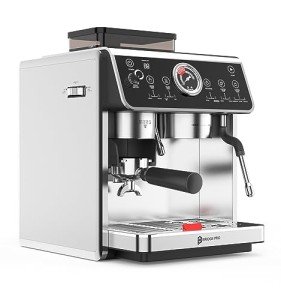The Rise of Home Espresso Machines: A Comprehensive Guide
As coffee lovers continue to look for fresh and delicious brews in the house, the appeal of home espresso machines has surged recently. No longer simply the domain of coffee shops and coffeehouse, these machines empower individuals to craft barista-quality espresso beverages from the convenience of their kitchens. This short article will check out the different types of home espresso machines, their functions, and considerations for choosing the right one. Additionally, it will supply a selection of FAQs to assist potential purchasers make informed choices.
Kinds Of Home Espresso Machines
Home espresso machines can be classified into numerous categories based upon their mechanisms and user-friendliness. Each type has its distinct features, pros, and cons.
| Type | Description | Pros | Cons |
|---|---|---|---|
| Manual Espresso Machines | Requires the user to by hand control the developing process, involving techniques like pulling a lever to produce pressure. | - Complete control over developing process - Compact design | - Requires skill and practice - Time-consuming |
| Semi-Automatic Machines | Machine automates water flow and pressure, however the user still manages the dosing and duration of the brewing procedure. | - Balance of automation and control - Versatile | - Learning curve for perfecting methods |
| Completely Automatic Machines | Automates the whole brewing procedure, from grinding to brewing, frequently with programmable settings for personalized drinks. | - Extremely user-friendly - Quick and convenient | - Less control over the developing process - Higher price point |
| Capsule or Pod Machines | Utilizes pre-packaged espresso capsules or pods to create coffee rapidly and easily. | - Extremely easy to use - Minimal clean-up | - Limited flavor variety - More pricey per cup than ground coffee |
| Super-Automatic Machines | Integrates features of completely automatic machines with built-in grinders, allowing users to brew whole bean espresso and milk-based beverages with one touch. | - All-in-one convenience - Ideal for milk-based beverages | - Often the most pricey - Can be bulky |
Functions to Consider
When picking a home espresso machine, potential purchasers must think about the following functions to ensure they choose a machine that fulfills their needs:
Grinder Type:
- Built-in mills can offer fresher premises however may require more upkeep.
- Different grinders enable more customization of grind size.
Pressure:
- Look for machines that produce at least 9 bars of pressure, which is ideal for brewing espresso.
Water Temperature Control:
- Machines with adjustable temperature level settings enable better extraction of taste from beans.
Milk Frothing Options:
- Consider whether you want a manual steam wand for frothing or an automatic milk frother for convenience.
Relieve of Cleaning:
- Machines with removable parts and self-cleaning functions substantially reduce cleanup time.
Size and Design:
- Ensure the machine fits comfortably in your kitchen and aligns with your aesthetic choices.
Budget:
- Set a budget before starting your search, as prices can range substantially from affordable models to high-end machines.
Benefits of Home Espresso Machines
Owning a home espresso machine provides many advantages:
- Cost-Effective: Over time, developing espresso at home can save coffee enthusiasts money compared to regular coffee shop gos to.
- Customization: Users can try out different beans, grind sizes, and brewing methods to discover their best cup.
- Convenience: The capability to brew espresso whenever gets rid of the need to go out to a coffee shop, especially helpful during late nights or mornings.
- Quality assurance: With a home machine, people have complete control over the quality of components and developing procedures.
Downsides of Home Espresso Machines
However, there are some disadvantages to think about:
- Initial Investment: High-quality espresso machines can be expensive, requiring a considerable upfront financial investment.
- Learning Curve: Mastering the art of espresso brewing can take time and practice, which might be frightening for novices.
- Maintenance: Like any device, espresso machines need routine cleaning and maintenance to make sure optimum performance.
FAQs
1. What is the best kind of home espresso machine for newbies?
Response: For novices, a semi-automatic machine is often advised as it offers a balance between control and automation, enabling you to find out the essentials without overwhelming intricacy.
2. How Read the Full Piece of writing should I invest on a home espresso machine?
Answer: Entry-level machines can begin around ₤ 100 to ₤ 300, while higher-end designs can range from ₤ 500 to over ₤ 2000. It's vital to set a budget based upon your anticipated use and desired features.
3. Do I need a different grinder?
Answer: While some espresso machines feature integrated grinders, purchasing a different grinder enables higher customization and guarantees better quality grounds.
4. How frequently should I clean my espresso machine?
Answer: Cleaning frequency can vary by machine type, however it's usually recommended to clean up the machine after each use and perform deep cleanings weekly or month-to-month, depending upon use.
5. Can I make milk-based drinks with any espresso machine?
Response: Not all machines include milk frothing capabilities. If you enjoy beverages like lattes or cappuccinos, try to find a machine with a steam wand or automatic frother.
Home espresso machines are changing the way coffee fanatics enjoy their precious brews. With different types and advanced features offered in the market, there is something for everyone. Whether it's the happiness of developing distinct recipes or merely relishing the ideal shot of espresso, purchasing a home espresso machine can improve both the coffee-drinking experience and the quality of life for coffee lovers all over. Just like any investment, it is vital to weigh the benefits against the prospective disadvantages and pick a machine that seamlessly fits both your lifestyle and preferences.

